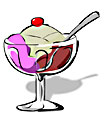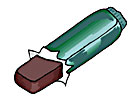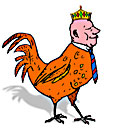|
|
 Foods Named After People: (Part Two) Foods Named After People: (Part Two)
by Marjorie Dorfman
Have you ever wondered why graham crackers are so named? Or who the man is behind Earl Grey Tea? Well, wonder no more as we further explore part two of foods named after people and vice versa.
|
|
This second article on the subject of food and the people named after them will cover the alphabet from G-M. In the interest of fair play, all names have not been changed to protect the non-innocent. Have fun with these. Someone has to.
G
Earl Grey Tea:
This tea’s namesake was Charles Grey, Second Earl Grey, Viscount Howick and British Prime Minister from 1830-1834. This tea bears no relation to author Zane Grey or that businessman who used to parade around in the flannel suit of the same color.
 Graham Crackers: Graham Crackers:
These crackers are named after a 19th century Presbyterian minister named Sylvester Graham. They epitomize his belief in a puritan lifestyle based on tee-totaling, vegetarianism and whole wheat. (He ate the crackers often, but how many parties he was invited to in his lifetime remains a moot point.)
Bombe Grimaldi:
This frozen, kummel flavored dessert was probably named after a 19th century member or relative of Monaco’s Grimaldi family.
 Cherry Garcia Ice Cream: Cherry Garcia Ice Cream:
Ben and Jerry created this ice cream flavor in homage to Jerry Garcia (1942-1995), who was the leader of the Grateful Dead rock band.
Garibaldi Biscuits:
These English biscuits, named after the famous patriot and leader of the drive to unite Italy, were created after his very popular visit to England in 1864. There is also a French sauce with mustard and anchovies and a consommé named after him.
H
Hass Avocado:
Rudolph Hass was a postal worker from California who back in the 1920s set out to grow a number of avocado trees in his backyard. One of the seedlings he bought was a variant that produced fruit, which was a bit unique. In 1935 he patented this variety of avocado, which now comprises 75% of US avocado production.
 Heath Bar: Heath Bar:
This American "English toffee" bar is named for Bayard and Everett Heath, two Illinois confectioners who developed it back in the 1920s. It eventually became very popular throughout the country.
Oh Henry!
The Williamson Candy Company of Chicago introduced this candy bar back in 1920. It was named for a young man who did odd jobs for the company store who was summoned by those words.
I
Timbales à la Irving
The chef at Delmonico’s (Charles Ranhofer), named this dish of meat or fish in a creamy sauce baked and served in a pastry shell after American author, Washington Irving.
J
 Apricots with Rice à la Jefferson: Apricots with Rice à la Jefferson:
The famous chef from Delmonico’s struck again with this special dessert named after the third president of the United States, Thomas Jefferson (1743-1826). This dish is made with Jefferson rice, a strain indigenous to Texas. Jefferson was very interested in improving the rice culture in the United States and he actually smuggled Piedmont rice out of Italy!
John Dory:
This is the English name for a saltwater fish that is also known as Saint Peter’s fish. It is said to be a reference to St. Peter’s job as doorkeeper to the pearly gates of heaven. Legend claims that the spots on the fish are either the apostle’s fingerprints or part of a story from the Gospel of Luke, which tells of a coin St Peter found in the fish’s mouth. (References to gift horses and mouths were from a later version of yet another book.)
K
Kaiser Rolls:
About 1497 a Viennese baker made these rolls for Emperor Frederick IV whose profile was stamped on the top.
 Chicken à la King: Chicken à la King:
There are several claims to this dish, none of which can be authenticated. One legend claims that William King of Philadelphia created this dish in 1915. Another insists that the original name was "Chicken à la Keene," and that it was named after a London-born American staying at the Claridge Hotel in London in 1881, just after his horse had won a major Parisian race. Two American chefs, our friend at Delmonico’s and chef George Greenwald of the Brighton Beach Hotel, claim to have created this dish for two wealthy Americans; one named Keene and the other King back in the 1890s. Whoever invented this dish, its true creator is full of chicken (and also another animal with horns that sometimes fights and sees red with a matador in a ring).
M
 Margarita: Margarita:
This tequila/lime orange liqueur cocktail has been claimed by many sources and no one can say for sure which one of them is the truth. One legend attributes the cocktail to Dallas socialite, Margarita Samas, who claimed she invented it in 1948 for one of her Acapulco parties. Enrique Bastate Gutierrez boasted that he invented the drink in the 1940s as a tribute to actress, Rita Hayworth, whose real name was Margarita Cansino. Still another unfounded tale connects the drink to an earlier time when Hayworth (who was the daughter of Flamenco dancers) was performing in Tijuana nightclubs under her original name.
This second article has covered ice cream named after rock stars, tea christened on behalf of Prime Ministers and cocktails claiming monikers of cinematic fame. Stay tuned for the third and most likely final piece on this topic, which will cover the letters, N-Z and maybe even beyond.
Happy Alphabet!
Did you know . . .
|
|
|
|
 |
|
|
Don't miss this excellent book:
The Earth Knows My Name:
Food, Culture, and Sustainability in the Gardens of Ethnic America
by Patricia Klindienst

Beauty and humor in a set of profiles of 15 valiant and thoughtful gardeners intent on preserving their native birthright and on restoring and protecting their adopted land. Woven into these stories are wide-ranging details of agricultural history: how to make blue corn piki bread, the fragrance of the sweet-sticky-pumpkin flower brought by refugees from Cambodia. Klindienst's writing shines when recounting her conversations with farmers. This book's broad scope touches on the best of nature writing, singing the rhythm of growth in both plants and people.
What's In A Name?
An article from Food Processing magazine
by Elizabeth Brewstar
This digital document is an article from Food Processing, published by Putman Media, Inc. on September 1, 1998. It runs 480 words and is delivered in HTML format and available in your Amazon.com Digital Locker immediately after purchase. You can view it with any web browser. Very interesting!
|

Click for a printer friendly version of this article.
|
|